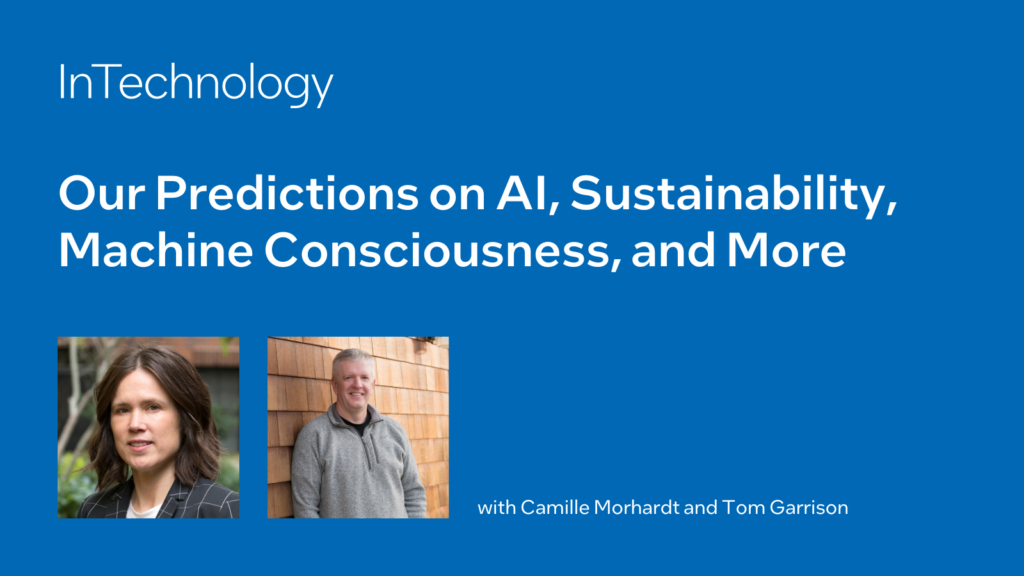[00:00:31] Stephen Harper: Hi, welcome to the Cyber Security Inside Podcast. I’m your host, Tom Garrison, and with me as always as my co-host, Camille Morhardt. And today we have a very special guest, Steven Harper. He is the Global Director of Environment and Energy Policy at Intel. He has over 30 years of experience shaping private and government policy regarding the environment, energy, climate change, and sustainability. And he’s currently a board member for the Energy Foundation. Welcome to the podcast Stephen.
[00:01:01] Stephen Harper: Thanks. Glad to be here, Tom.
[00:01:03] Tom Garrison: Wow, 30 years in this industry. That’s quite a tenure. So we wanna spend today talking, you know, there’s been so much that’s been spoken and written about the CHIPS Act and about the Inflation Reduction Act and other things that are in the news. And so we’ve figured this would be a great topic for people that just wanna understand what’s the current state of regulations and so forth, and it’s so complicated.
We figured you’d be a great person to sort of explain it. So maybe we’ll start with the CHIPS Act and what is it? What does it actually mean–not the marketing messages–but what does it actually mean for us Intel as well as for the industry?
[00:01:45] Stephen Harper: Well, I think it means a couple of things, Tom. I think financially it’s going to help close the gap between what it costs to build a fab in the United States and what it costs to build a fab in particularly Asia. And I should say Europe is also passed their own version of a similar piece of legislation.
So, you know, the, the vision is that the CHIPS Act will basically restore leadership in high-end manufacturing in our industry. I don’t remember the exact figures, but something like 30 to 40% 25 years ago to a fraction of that today. So that’s the first thing. It’s gonna help incentivize construction of the fabs, for example, Ohio, Intel’s Cardinal Project.
[00:02:31] Tom Garrison: And can I ask a quick question, too? Why is it that it costs less to build, say a factory over in other countries as opposed to US? Is it just labor costs or is there something else going on there?
[00:02:44] Stephen Harper: No, labor costs are part of it because in the construction world, it’s labor intensive as opposed to say the fabs where labor costs are less of a factor once you start operating.
The biggest reason it’s cheaper, for example–particularly in Taiwan and China– is because the governments provide incentives; they provide subsidies that make it a lot less expensive. So this is essentially the US and Europe getting into the game that others have been playing for some time.
The second reason why CHIPS is important is on the research side It sets aside several billion dollars for the creation of something called the National Semiconductor Technology Center, NSTC. Although the structure and format of that institution has not been settled on yet, however it’s structured, it’s gonna provide a huge amount of money for cutting edge research into components, into energy efficiency. There’s gonna be a chunk of it that will go for what we call “green chemistry” to reduce our, uh, industry’s environmental footprint.
And some of that money will go to companies for proprietary, patentable research, but a lot of it is gonna go for what we call pre-competitive research, particularly in the environmental arena where we’ve got some fundamental problems that we’ve gotta address going forward, and there just hasn’t been enough money and enough brain power put towards solving those problems. The NSTC will really help close that gap, as well.
[00:04:18] Camille Morhardt: Could you tell us what some of those problems are?
[00:04:21] Stephen Harper: Yeah, so in the environmental arena, there’s several, what I call existential issues. In our processes, we use fluorine because of its stability, its non-reactivity it is very useful in the photolithography process. We use fluorinated gases, and those gases are high global warming gases. So carbon dioxide has a global warming potential of 1. Some of the fluorinated gases we use are in the thousands, and then on the aqueous side, some of the fluorinated chemicals are what they call PBTs, Persistent Bio-Accumulative Toxins. We use very small quantities of these chemicals and these gases, and we have no substitutes currently. And the only way we’re gonna get to our net zero commitment is if we solve the fluorine problem. We’ve made progress, but there are no substitutes.
And the other part of it is the government’s not gonna ban our use of these substances because there are no substitutes. While we look for substitutes, they’re probably gonna require us to get to what we call zero release, so that even though we’re currently releasing very small amounts, in some cases, non-detectable amounts into the environment, the government’s gonna say “you gotta go to zero.” As an industry, we don’t know how to do that yet. So the NSTC will hopefully help us focus an adequate amount of resources on those kinds of problems.
[00:05:51] Tom Garrison: So these are monies that are set aside for scientific innovation, and this is within the CHIPS Act?
[00:05:58] Stephen Harper: Right
[00:05:59] Tom Garrison: Is the same true also for the Inflation Reduction Act? Do they have money set aside for invention in this regard?
[00:05:39] Stephen Harper: Not in the semiconductor industry specifically. So the Inflation Reduction Act, which is a funny name for… It’s called that for political reasons because it does increase some taxes, but essentially it’s a set of incentives for renewable energy. And it should be viewed in tandem with a bill that passed the year before, which everybody refers to as the Infrastructure Package. So the two combined provide hundreds of billions of dollars of incentives for renewable energy development. And there will be a huge amount of benefit to our industry from those expenditures because–whether it’s a solar array or a wind development—there are a lot of CPUs that go into those kinds of projects.
Also, there’s a lot of our technology that’s involved, for example, at what they call the grid substation–the distribution side of the energy grid–that enables the incorporation of more renewables. And that involves a lot of servers. It involves a lot of virtualization. Those two bills taken together are gonna provide a big incentive.
And they’ll also, importantly–assuming that the renewables build out is expected–that’s gonna make it a lot easier for companies like Intel that want to be a 100% renewably powered to meet that objective. And it’s also gonna make it easier for data centers–whether they’re Intel data centers or cloud service provider customer centers–to be powered by renewable energy, which is very important because data center energy consumption is expected to dramatically increase over the next 15 to 20 years.
[00:07:59] Tom Garrison: Uh-huh.
[00:08:00] Camille Morhardt: What are some of the bottlenecks that different areas in compute are gonna be looking at through this funding? And I’m asking, you know, for example, we just talked with somebody on What That Means about the fact that converting just even all of the vehicles in the United States to electric would require more of certain kinds of minerals than we even have in known existence on the planet today. So I’m interested in those kinds of bottlenecks where there is really no line of sight currently.
[00:08:39] Stephen Harper: Well, you bring up an interesting point. I think that that claim that you just cited is an exaggeration. You know, it turns out that minerals, these are economic markets and when demand rises for anything, price goes up and it makes it economic for people to find new reserves or to tap previously known but uneconomic reserves–whether it’s rare earth or lithium, to cite an example in terms of batteries.
But I think the point you’re making overall is correct. There really are two potential roadblocks to the full build-out of renewables as envisioned in the two acts we, we talked about the two laws. The first is permitting. Anything that involves federal funding typically has to go through the, what’s called the National Environmental Policy Act, or NEPA. And that involves an environmental impact statement. And this, by the way, could apply to the CHIPS Act projects, as well. Permitting processes can take three plus years and can involve lots of litigation, which really slows things down. So there’s a lot of attention being paid in the Administration and Congress in industry right now to how do we fundamentally streamline the permitting process so that the environment is protected, but so these projects can go forward.
You know, the other is what you refer to Camille, and that is the natural resources that are embedded in these projects once they’re built. And renewable energy is not completely green, right? It’s got embedded energy and embedded natural resources over the life of a solar installation or a wind installation. That embedded energy, that embedded materials in terms of its environmental impact is dwarfed by the benefits over the long run, but it’s not a zero cost. There are some trade offs, and so what I think people are starting to look at is where can we go–particularly in the United States or Canada or other countries that are politically stable and friendly–where can we go to find additional reserves of these elements? And in a lot of cases, they’re not necessarily all that rare.
So for example, rare earth, we don’t use very many rare earths directly; some of our suppliers do. Turns out rare earths generally are not that rare. It’s just they tend to be found in places they’re hard to get at or they’re very dilute in some other ore and so it, it just requires expenditure of funds. Increased price will create increased supply. But uh, opening mines is an environmentally hazardous endeavor. And so there’s gonna have to be a permit process that allows for the exploitation of those necessary ingredients to the clean energy transition, but does it in a way that’s protective of the environment. And so that’s gonna be a real challenge going forward.
[00:11:51] Tom Garrison: A couple things struck me while you were talking there and one of them is I’ve read in multiple places that Intel, at least in the US, is already 100% renewable energy.
[00:12:03] Stephen Harper: Correct.
[00:12:04] Tom Garrison: So when we talk about Intel, specifically, we’re not completely a hundred percent renewable outside the country, which I think is the last bit to be to made a hundred percent renewable. Is that correct?
[00:12:15] Stephen Harper: Yeah. I think, and I forget the exact number, but I think we’re at about 80%, 75 to 80% renewable, globally. I think the primary places where we’re not at a hundred percent are China and Vietnam, and that has to do with the markets for electricity in those countries. But you know, we’re gonna grow, obviously. We hope we’re gonna grow. And so as we grow, we are gonna need to take on additional renewable energy, either directly or through the markets to continue to hit that a hundred percent in the US and our goal is a hundred percent globally.
[00:12:27] Tom Garrison: Yeah. And then the second element, which I’ve heard before, and I have my own opinions on this one, but I figure you’re, you’re far more the expert than I, is the naysayers that say, Well, why a company like Intel makes billions of dollars every quarter. “Why is it that Intel needs a whole bunch of money from taxpayers to go be successful?” Right. There’s already lots of money in the system. How would you respond to that in terms of both the sustainability kind of aspects, but also things like just the standard CHIPS Act and building fabs in Ohio and, and you know, other places in the West?
[00:13:32] Stephen Harper: Well, I would respond on sort of two levels. The philosophical level, which I’ll try not to go on about too much is, you know, there’s a debate about what economists call industrial policy, right? Should governments pick winners–whether industries or companies–and subsidize individual industries. And I’m an economist by background, and the calculus is impeccable and the graphs are impeccable that show that if every country were to play by the rules where nobody tries to subsidize any industry, they go with the industries that they’re best at and have zero tariffs, that the world would be better off, and I think is a mathematical proposition, that’s correct. However, no country that’s currently rich or is on the way to getting rich has ever played by those rules.
So you know, the alternative to that sort of laissez faire, free market approach is what is called mercantilism or industrial policy. And in the United States, politically, there’s been this back and forth over which is the right way to go. Usually industrial policy wins, and in fact, in our industry, one of the most successful examples of industrial policy is Semitech, which those of us have been around long enough will remember. Back in the seventies, it looked like the entire memory market and all the, the market for companies making the machines that made memory chips was gonna go to Japan. And Andy Grove led the industry to get the federal government in the Ford Administration, I believe, to create something called Semitech in Austin, which was a consortium of US manufacturers to push… it was almost like a NSTC predecessor, right? Or a, a prequel where there was a lot of money spent by government and industry to promote advancement of cutting-edge technology. And that really helped save the, the industry. So there is an example of industrial policy working for us.
At a more practical, fundamental level, I would say that the reality is companies like Intel, our board has a fiduciary responsibility to its shareholders to make sound fiscal decisions. And given the gap in what it costs to build a fab in Asia versus build a fab in the United States and now given the fact that they’re increasing national security concerns about the growth of the industry in China, specifically, you know, I think it’s just a practical argument that there’s no way that companies like Intel are gonna continue to invest in the United States if it’s much less expensive to invest in other countries; because A) they’re competing against companies in those regions, and B) as I say is a legal matter, the board has this fiduciary responsibility to do the right thing by the shareholders, so…
[00:16:44] Camille Morhardt: You hit on something I really wanna explore for just a minute too. When you mentioned there is fundamentally a single bottom line for corporations and yet we’re hearing a lot of movements, I think, across corporate America, I’ll just say toward embracing sustainability–be it through renewables or other means. And I’m wondering, I can understand why an individual human would make those decisions, but why are companies moving in that direction? What is causing that shift? And because we don’t actually have a triple bottom line, why are they doing it?
[00:17:20] Stephen Harper: Well, in some respects, we kind of sort of do have a triple bottom line. You know, it’s the difference between shareholders and stakeholders. And so my comments before about fiduciary responsibility is not to suggest that the board only takes that into account or that management only takes that into account.
Increasingly, the people who are investing–the investment funds–are moving, uh, for their own reasons towards what they call ESG investing, Environmental, Social, and Governance investing, where they’re looking at not just the financial bottom line, but also, for example, the climate change exposure of companies.
A really big factor is the employee base. You know, if you want to attract and retain, I forget, are we in Gen X or whatever the new generation is coming out of college and graduate schools, but even, you know, old farts like me, if you want to attract and retain really topnotch people, you gotta show that you’re responsible socially responsible environmentally, because the employees care about that stuff.
I’ll just tell you quick story that illustrates the change in the 25 years that I’ve been at Intel. We used to have a program called right, W-R-I-T-E To Know. So an employee could write in, ask a question, and it’d get directed to somebody in the company who was deemed to be appropriate to answer the question.
So years ago when, uh, so-called Cap and Trade Climate bills were being considered in Congress, I did an article talking about what the bills would do and what Intel’s position on the bills were and why we were involved. And, you know, we were trying to be part of the solution. We weren’t fighting the bills, we just wanted to help shape them in the way we thought was best. Almost every response from Arizona was, “I’m a shareholder. Why the hell are you wasting my money on this BS?” Often it was phrased much more colorfully than that. From Oregon, virtually all of the responses were, “Why are you bothering to tinker with this? You should just accept what’s given to you.” You know, it’s like “we should do more.”
Today just based upon my own interactions–no scientific sample–with employees around Intel in the United States, I think if I were to write something today about what we’re doing on these acts we’re talking about, I would get a hundred percent green response. I think that’s a huge consideration, and it’s particularly a huge consideration for a tech company.
[00:20:02] Tom Garrison: We’ve talked about some of these acts or that have just recently sort of been passed, but what is happening in Europe? and then also what is happening that you can foresee, I guess, in the near future? What, should our listeners sort of expect to see from governments and regulatory bodies in the near future?
[00:20:23] Stephen Harper: Europe is doing quite a bit through what they call the European Green Deal, which is a multi-layered set of proposals, which they are acting very rapidly on that will promote the expansion of green energy, particularly in Europe. Now you’ve got an interesting situation playing out. This is gonna be a painful winter for Europe if you believe the prognosticators. The rise in the cost of natural gas coming from Russia is really gonna pinch the European economy. And you can see two, I’m not an expert on European politics, but you can see two sort of schools of thought developing over this. The first is, well, Europe needs to develop more conventional fossil fuel sources in the immediate future because you know, we can’t have the price of natural gas from Russia going up by five times or whatever. The other is on the green side, and I think this is the predominant voice that says we’ve got to double down on renewables. So that’ll be an interesting debate to see how it plays out.
[00:21:34] Camille Morhardt: I’ve heard it said before that in order for there to be a real transformation in sustainability, renewable energy needs to be cheap and plentiful. And I’m wondering what your take is on that and how quickly we might arrive at that and whether, as a third part, There need to be any significant infrastructure changes for us to get there?
[00:21:58] Stephen Harper: Well, on the first bit, we’re already there. The reason why the US has made significant greenhouse gas reductions over the last particular 10 or 15 years is because the price of renewable energy, wind and solar principally, has really dropped dramatically. It varies from region to region, but in general is cheaper now than natural gas, and certainly cheaper than coal.
Coal-fired power plants are being phased out because they’re just not economic. No bank will invest in the construction of a new one, and utilities are looking to go renewable as fast as they can. And by the way, in a lot of states, in the Midwest, which are Red states–you know, they vote Republican–they have strong renewables programs because it’s jobs. And it’s cheaper electricity, and so to some extent we’re already there.
If the incentives that are in the infrastructure package and the IRA legislation play out in anything like they’re envisioned, that is really gonna spur–again, assuming we can get the materials that you talked about earlier at Camille–that’s really gonna spur an even faster decline in the cost of renewables.
Now, there is one significant problem besides the materials issue that Intel is involved in trying to address, and that is the state of the electricity grid. Right now, there are a lot of places in the country where there are excess renewables that just get curtailed because the grid can’t handle them at a particular time. And the grid has to be balanced between supply and demand on a second by second basis.
So one of the problems is we need cheaper and better long-term battery storage. So when there’s excess renewables, sun or wind, if you can store that and then, draw down that stored electricity when the renewables aren’t available, then you get a much more sustainable renewable-based grid. And there’s a lot of progress being made to drive down the cost and improve the ability to store. So that’s number one.
The other is just the antiquated nature of the infrastructure well, and politics. So there’s two pieces to the grid, very simplistically: transmission, you know, that’s taking the energy from the plants and generally transmitting those electrons over a long distance. And then there’s distribution, where you step down the voltage and deliver the electricity to your home or your business. On the transmission side, you got a ton of sun In Texas, you got a ton of sun in the. You got a ton of wind in places like North Dakota. How do you wheel those electrons from North Dakota to Chicago? Well, you gotta build transmission lines and people don’t like transmission lines. It’s the not-in-my-backyard or NIMBY syndrome. So that’s a political problem.
But the physical problem is the distribution grid is 50, 60, 70 years old. Two winters ago when Texas basically froze, a lot of it was because the basic grid, first of all, wasn’t connected with the rest of the country, and it was based upon really ancient mechanical technology.
Where Intel comes into play is through our Internet of Things group. Um, this is something that a colleague, um, Mike Bates is leading the effort. They’re working with Dell to basically develop virtualized substations, which are essentially server racks. And these, uh, systems can provide all kinds of benefits to utilities, including the greater ability to incorporate renewables, what they call distributed renewables into the local grid.
[00:26:01] Tom Garrison: I know Camille and I will be diving into a lot of the technology aspects for various sustainability capabilities that are coming in future podcasts. But Steven, from a regulatory standpoint and just giving us a glimpse into what’s going on, this has been really helpful. So thanks for joining us today.
[00:26:21] Stephen Harper: Well, thanks for the opportunity. I appreciate it.




